|
In memory of those who fought for our freedom Herinnering aan onze bevrijders
Legeronderdeel: | Nummer: Geboren: Overleden: Begraafplaats: 1/5th Bn. Queens Royal Regiment | 4037280 20 februari 1926 Poplar, Londen 13 januari 1945 Baakhoven Nederweert IV.C.7
| Short lifestory: Thanks to: Tamsyn Taylor My Great Uncle George Sidney Green or ‘Sid’ as he was called by his older brother, my grandfather, Ernest James Green. Was born in Poplar, London 20 February 1926 as son of Frederick Willie and Florence Green (nèe Skeels). The family lived at 25 Parsonage Street, Poplar, London until they moved at the start of the war during the ‘Blitz’ to 12a Cardinal Ave, St. Budeaux, Plymouth. Unfortunately, almost as soon as they arrived Germany accelerated its blitzkrieg, identifying Plymouth as an important target. With its dockyards, naval, army and commando bases itís hardly surprising. In fact Plymouth was levelled with huge numbers of casualties. It must be around that time George Sidney joined the British Army. My grandfather spoke of Sid all the time. His favourite story was about when Sid was a Butchers Boy in Plymouth prior to enlistment. He would deliver meats to the butcherís customers and one Christmas, according to Grandad, Sid felt sorry for some of the less well off and elderly of the community. He proceeded to deliver the Butchers chickens (free!!) to those who had nothing so they would get a Christmas dinner. Needless to say the butcher wasnít best pleased! In January 1945 the family received a notice that their son/brother George Sidney was killed in action at the age of 18 years. 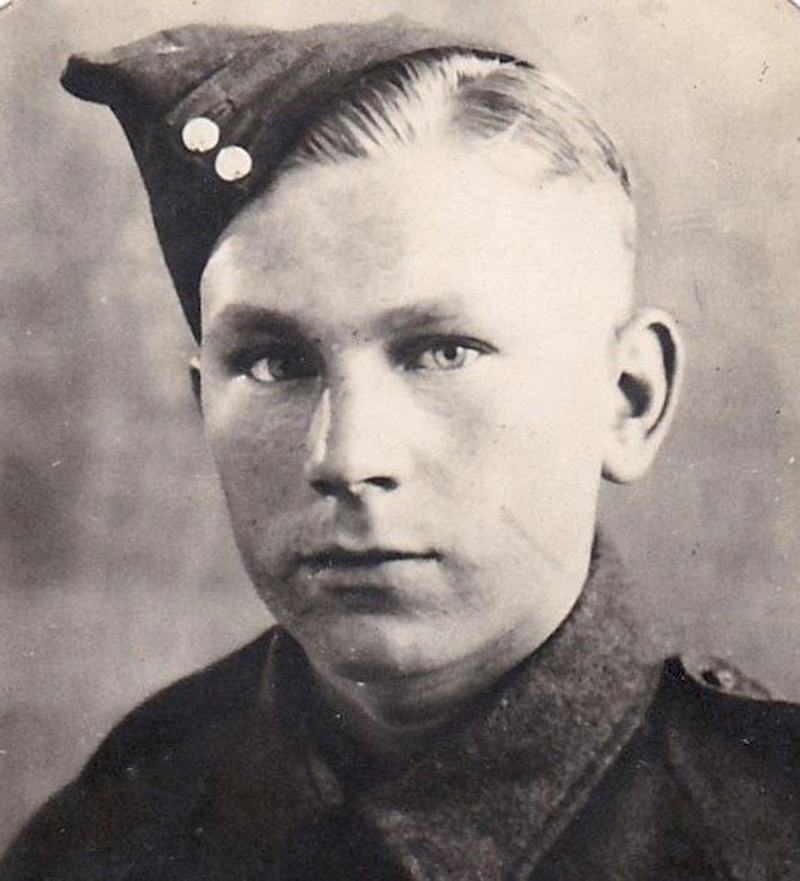 George Sidney Green in militair uniform. Met dank aan:/Thanks to: Tamsyn Taylor Als Brits soldaat maakte hij als Private onder nummer 14724039 deel uit van de 1/5th Bn. Queens Royal Regiment voor aanvang van operatie “Blackcock”. Spijtig genoeg sneuvelde ‘Sid’ op 13 januari in of nabij Baakhoven tijdens hevige gevechten waarna hij in eerste instantie werd begraven in de tuin van Gori Vonken te Baakhoven. Op 16 april 1947 is hij herbegraven op het ‘War Cemetery’ te Nederweert. Een afschrift van deze gevechten zoals deze is opgetekend in het “War Diary” van de 1/5th Queens volgt hier. Met tussendoor enkele afbeeldingen uit het Soldier's service book van George Sidney Green. THE CAPTURE OF BAKENHOVEN, by 1/5th Bn The Queen's Royal Regiment on 12 Jan 45. At 1030 hrs on the 12 Jan 45 the Bn was ordered to do a night attack on the village of BAKENHOVEN, with the object of capturing it and forming a firm base for the lauching of the operation "BLACKCOCK" wich was scheduled to start two day later. To understand the difficulties of the operation, a word must be said firstly about the ground and communications, and secondly about the weather. The ground round BAKENHOVEN is inundated with canals and dykes, the village itself being entirely surrounded by a dyke and a canal. The only road supplying it is a third rate soft-mud single track. The weather was appalling, the countryside being covered with snow, wich had melted in places, then frozen into solid sheets of ice, made even more treacherous by subsequent falls of snow and sleet, to wich add patches of dense fog and mist. It was decided to put in the attack at 0500 hrs in the morning, supported by a tp of Flails and an Artillery Barrage, the entire attack being supported by track vehicles only, owing to the ground. Before the attack could be launched a Scissor Bridge had to be placed in position across the dyke at point 660757 to enable the Flails to be launched into the attack. Just before last light on the 12 Jan all vehicles including the Flails and the Scissor Bridge RV at the rd junction point 657739 at Holtum under the 2IC Major G.Ball DSO and proceeded under cover of darkness to the village of GEBROEK 6575 from where the attack was to be launched. To assist in getting surprise a tp of tanks had been stationed at GEBROEK for some days previous to the attack, the tanks consistently starting up their engines, to accustom the enemy to the presence of track vehicles in the village. On arrival in the village the bridge was immediately placed in position over the dyke, the noise being covered by an Artillery stonk. At 0200 hrs on the morning of the 13th Jan, the company carrying out the attack ‘D’ Coy comd by Major V.Lilley) embossed and proceeded to the village of BUCHTEN 6473 where they debussed and proceeded on foot to the village of GEBROEK 6575 where they arrived at 0420 hrs and proceeded to form up for the attack. Bn TAC HQ for the attack was established at GEBROEK 6575. PLAN OF ATTACK The plan for the attack was as follows:- The Coy was to follow the tp of Flails over the Bridge accompanied by a sec of carriers, a sec of Res, the pnr pl and the gunner OP tank, to the start line. On crossing the start line the inf preceeded by the Flails would advance on the village of BAKENHOVEN under cover of a quick Artillery barrage of six lifts, to be put down by ‘J’ bty the 3 RHA. During the advance and assault on the village the Bofors AA guns were to fire tracer over the heads of the inf to help the attacking tps to keep direction. The carrier sec was responsible for the right flank protection. Throughout the attack the MMG pl and the Bn 3" mortars were to harass the canal banks to the east of BAKENHOVEN (known enemy positions). 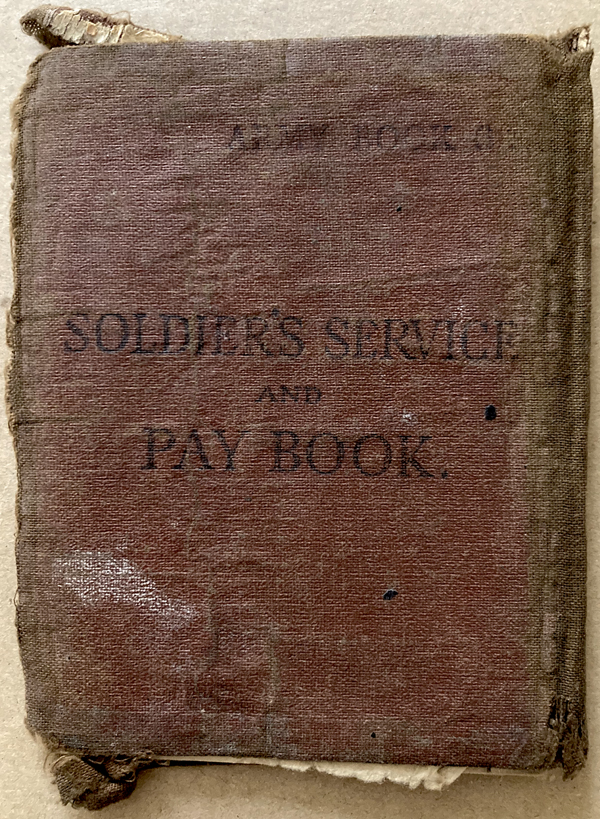 Soldier's servicebook van George Sidney Green. Met dank aan:/Thanks to: Tamsyn Taylor THE ATTACK The attack went according to plan, though great difficulty was experienced in getting the Flails over the Bridge on account of the ice. The Gunner OP tanksgot stuck on the scissors but was eventually got off, though the bridge became strained. The bridge after the initial surprise had worn off, was periodically shelled and mortared by the enemy. In the rear of the attack a sec of carriers followed up carrying 48 hrs rations, A per mines and reserve ammunition. The Flails cleared three paths through the A per minefiled that surrounded the village, wich was lightly held by the enemy, enabling the inf to get in and clear it. BAKENHOVEN was firmly in our hands by 0630 hrs. All the houses were found to be heavily booby-trapped except a few that had been occupied by the enemy. By first light the Coy was firm and dug in, though there was not sufficient time to put down wire or A per mines. A screen of snipers were immediately pushed out to the east, who reported a number of the enemy dug in on the west bank of the canal about 250 yds to the east of BAKENHOVEN. On completion of the attack the tp of Flails returned to GEBROEK, but on the second Flail attempting to cross the scissors, the bridge collapsed the Flail and all being deposit in the dyke, so the remaining Flail was ordered to rejoin the garrison at BAKENHOVEN. So when day broke the village of BAKENHOVEN was firm in our hands held by a company supported by a sec of carriers, the Gunner OP tank, one Flail tank and the pack carriers, also the Pioneer pl and a sec of REs, but all communication by road had gone owing to the collapse of the bridge. There is no question that complete surprise was obtained, with resultant light casualties, and owing to the late hour of the launching of the attack the enemy did not have sufficient hours of darkness to mount a counter-attack the same night. Throughout the night movement light was employed which proved a great success. The greatest trouble was expierenced with the vehicles on the ice track, over ten vehicles being badly ditched during the nights, however all were recovered in time for the operation except one Flail that became hopelessly bellied. During the day of the 13 Jan the tps in BAKENHOVEN were heavily shelled and mortared by SP guns and 3.2" mortars situated across the canal to the east of the village. 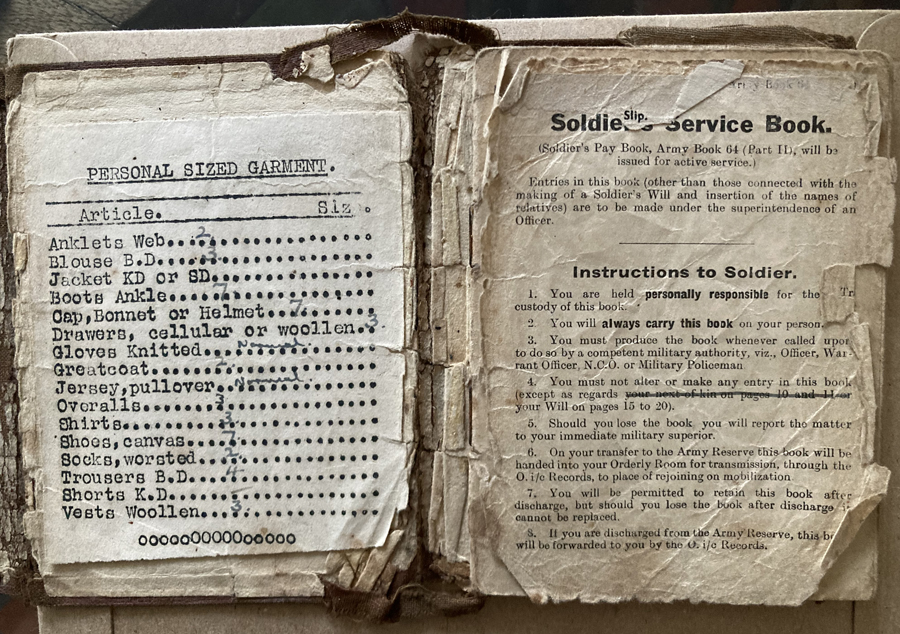 Soldier's servicebook van George Sidney Green met standaarduitrusting. Met dank aan:/Thanks to: Tamsyn Taylor THE COUNTER-ATTACK That evening the CO and the Adjutant arrived at 1725 hrs to visit the tps. At 1745 hrs while the CO and Coy Comd were in the act of going round the pl positions the enemy opened up a heavy barrage of shells and mortars, thickened up with MMG and Spanday fire, the fire came in from the north, the east and the south east, with fixed lines firing down every road in the village. Our tps were just about to stand down. The timing of the attack was perfect, the enemy coming in just as the light failed right under their Atillery barrage and MMG fire. They were all a very good tough type of young GAF tps, and all wore snow suits that made them very hard to see against the snow in the failing light. The rights hand fwd pl was almost immediately overrun, suffering fairly heavy casualties, the men stuck to their posts, and held out in certain isolated points throughout the action. The enemy penetrated into the middle of the fwd left hand pl and were there held. The enemy were milling about all over the Coy position. The CO took over control at the Coy HQ and put in a request to the DLI (under whom ‘D’ Coy had passed to on the capture of BAKENHOVEN) for reserves to be sent up at once, while the Coy Comd Major Lilley collected a mobile reserve from all available resources and personally led a counter-attack on the enemy in the fwd right hand pl position, this attack was led with great dash and bravery and completely restored the position, from there he systematically cleared every Hun from the company area - the reserves arrived just after the last German had been expelled or killed, but were of great value in the reconsolidation. 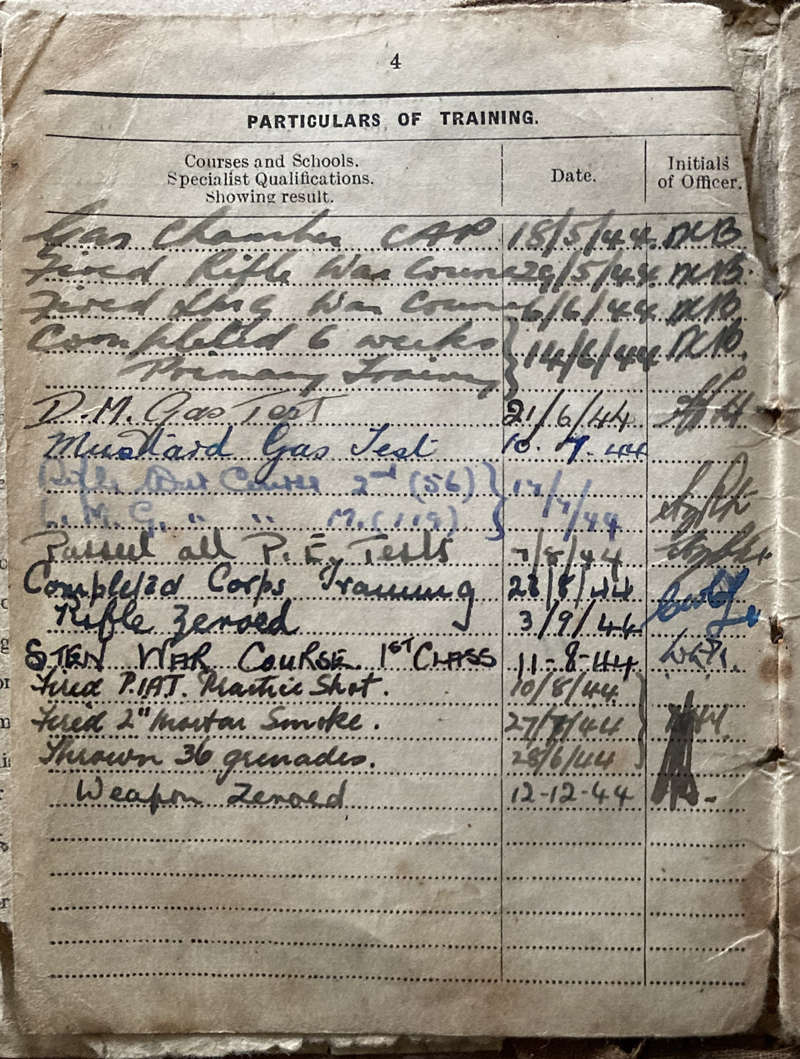 Soldier's servicebook van George Sidney Green met volbrachte oefeningen. Met dank aan:/Thanks to: Tamsyn Taylor The enemy left 25 men dead on the ground but managed to remove their wounded. Our casualties were 1 killed and 15 wounded. It is estimated that the enemy attacked with about 70 men, the action lasting for just under two hours. At 0100 hrs on the 14th Jan ‘B’ Coy, Comd by Major John Evans DSO, relieved ‘D’ Coy, and during the hours of darkness, wired and booby-trapped the fwd approaches to the village. Movement light was switched on during this action, and was of great value to the defenders. The Gunner OP put up a really magnificent performance throughout the action. (Capt W.Dolphin Smith RA). 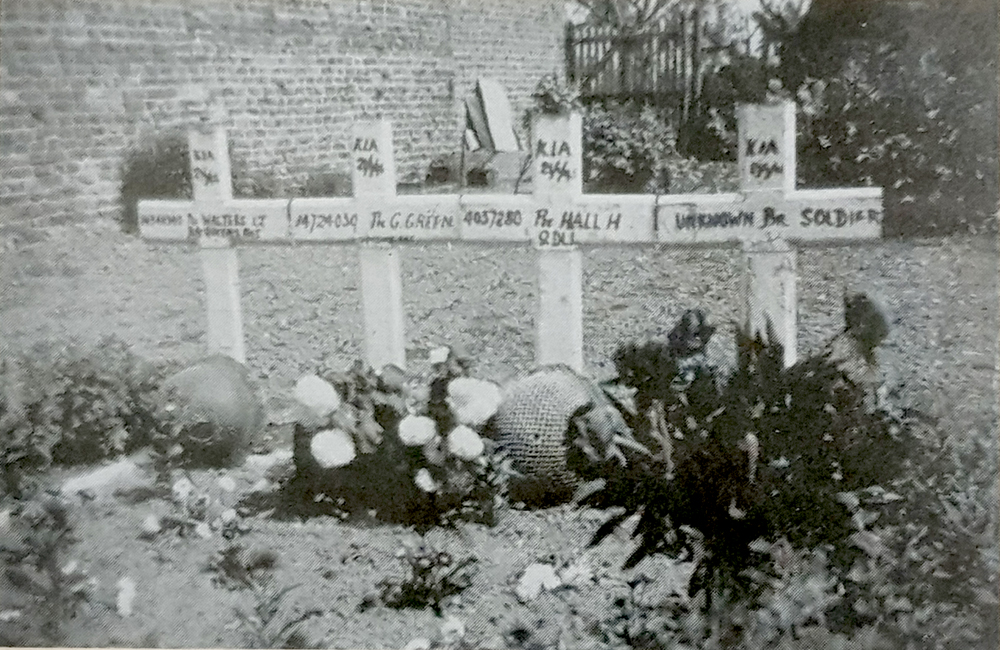 De tijdelijke begraafplaats in Baakhoven, een van deze kruisen markeert het graf van George Sidney Green. Circa 16 april 1947 werd hij herbegraven op de Militaire begraafplaats te Nederweert. 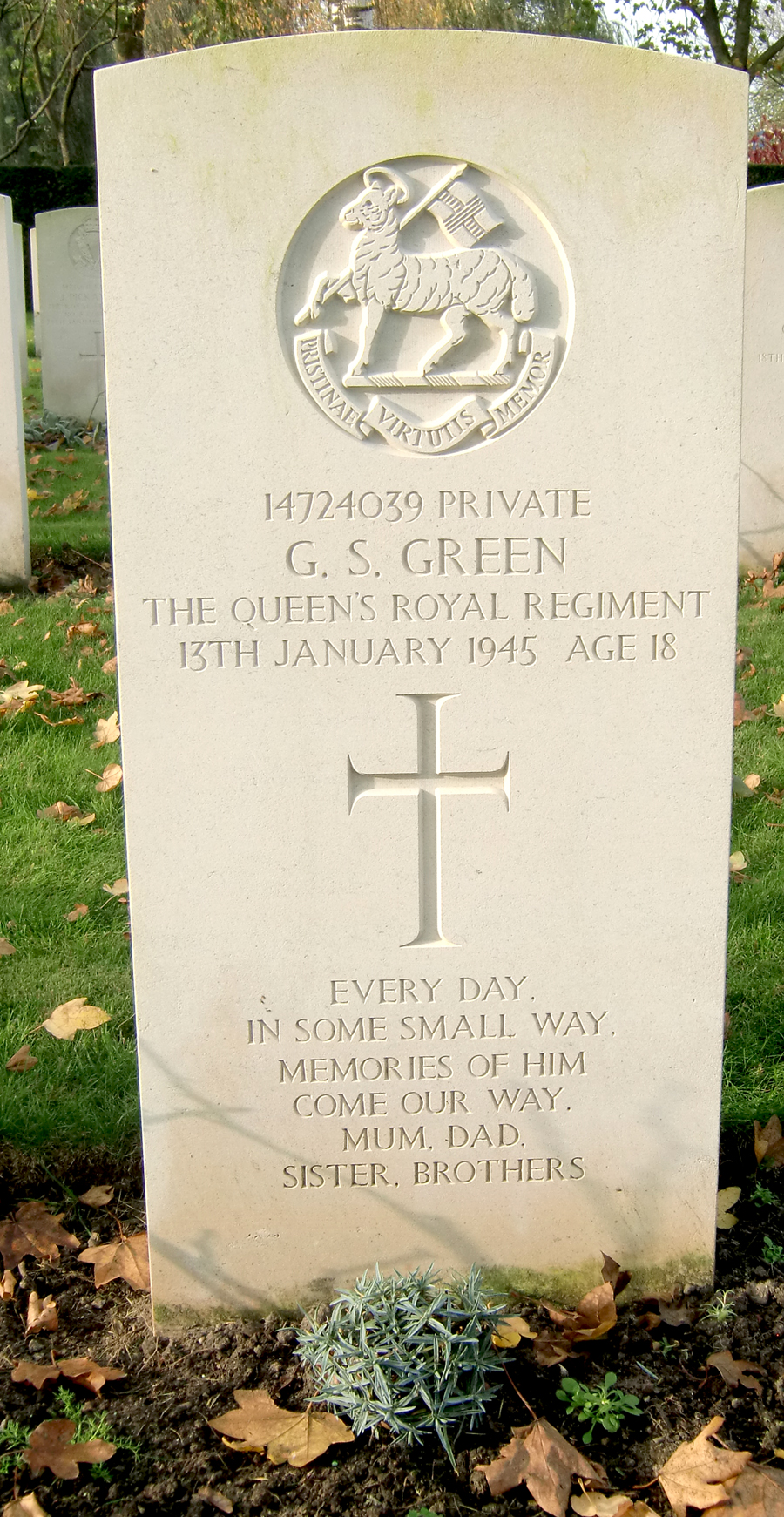 Grafsteen George Sidney Green op de War Cemetery in Nederweert Misschien zijn er nog mensen die informatie hebben over die tijd zoals verhalen of foto's. Neem dan contact op met de webmaster info@deetere.nl wellicht kan het bijdragen aan de geschiedschrijving van onze streek en mogelijk ook van belang voor familieleden van onze bevrijders! | ||